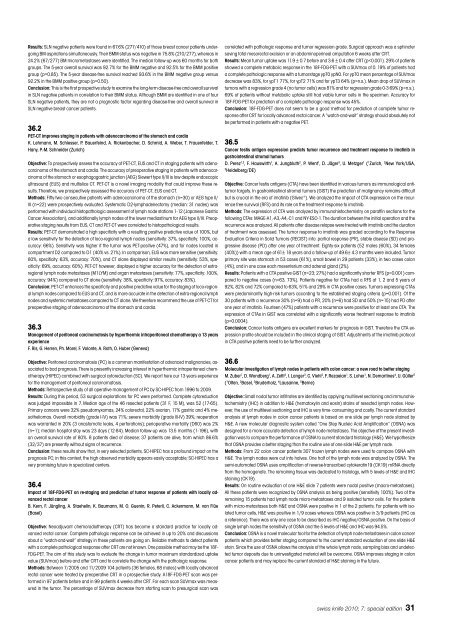Anorectal Manometry in 3D NEW! - Swiss-knife.org
Anorectal Manometry in 3D NEW! - Swiss-knife.org
Anorectal Manometry in 3D NEW! - Swiss-knife.org
You also want an ePaper? Increase the reach of your titles
YUMPU automatically turns print PDFs into web optimized ePapers that Google loves.
Results: SLN negative patients were found <strong>in</strong> 67.6% (277/410) of those breast cancer patients undergo<strong>in</strong>g<br />
BM aspirations simultaneously. Their BMM status was negative <strong>in</strong> 75.8% (210/277), whereas <strong>in</strong><br />
24.2% (67/277) BM micrometastases were identified. The median follow-up was 60 months for both<br />
groups. The 5-year overall survival was 92.7% for the BMM negative and 92.5% for the BMM positive<br />
group (p=0.85). The 5-year disease-free survival reached 93.6% <strong>in</strong> the BMM negative group versus<br />
92.2% <strong>in</strong> the BMM positive group (p=0.50).<br />
Conclusion: This is the first prospective study to exam<strong>in</strong>e the long-term disease-free and overall survival<br />
<strong>in</strong> SLN negative patients <strong>in</strong> correlation to their BMM status. Although BMM are identified <strong>in</strong> one of four<br />
SLN negative patients, they are not a prognostic factor regard<strong>in</strong>g disease-free and overall survival <strong>in</strong><br />
SLN negative breast cancer patients.<br />
36.2<br />
PET-CT improves stag<strong>in</strong>g <strong>in</strong> patients with adenocarc<strong>in</strong>oma of the stomach and cardia<br />
K. Lehmann, M. Schiesser, P. Bauerfe<strong>in</strong>d, A. Rickenbacher, D. Schmid, A. Weber, T. Frauenfelder, T.<br />
Hany, P.-M. Schneider (Zurich)<br />
Objective: To prospectively assess the accuracy of PET-CT, EUS and CT <strong>in</strong> stag<strong>in</strong>g patients with adenocarc<strong>in</strong>oma<br />
of the stomach and cardia. The accuracy of preoperative stag<strong>in</strong>g <strong>in</strong> patients with adenocarc<strong>in</strong>oma<br />
of the stomach or esophagogastric junction (AEG) Siewert type II/III is low despite endoscopic<br />
ultrasound (EUS) and multislice CT. PET-CT is a novel imag<strong>in</strong>g modality that could improve these results.<br />
Therefore, we prospectively assessed the accuracy of PET-CT, EUS and CT.<br />
Methods: Fifty-two consecutive patients with adenocarc<strong>in</strong>oma of the stomach (n=30) or AEG type II/<br />
III (n=22) were prospectively evaluated. Systematic D2-lymphadenectomy (median: 31 nodes) was<br />
performed with <strong>in</strong>dividual histopathologic assessment of lymph node stations 1-12 (Japanese Gastric<br />
Cancer Association), and additionally lymph nodes of the lower mediast<strong>in</strong>um for AEG type II/III. Preoperative<br />
stag<strong>in</strong>g results from EUS, CT and PET-CT were correlated to histopathological results.<br />
Results: PET-CT demonstrated a high specificity with a result<strong>in</strong>g positive predictive value of 100%, but<br />
a low sensitivity for the detection of loco-regional lymph nodes (sensitivity: 37%, specificity: 100%, accuracy:<br />
66%). Sensitivity was higher if the tumor was PET-positive (47%), and for nodes located <strong>in</strong><br />
compartment D2 compared to D1 (40% vs. 21%). In comparison, EUS was more sensitive (sensitivity:<br />
80%, specificity: 63%, accuracy: 70%), and CT alone displayed similar results (sensitivity: 53%, specificity:<br />
69%, accuracy: 60%). PET-CT however, displayed a higher accuracy for the detection of extraregional<br />
lymph node metastases (M1LYM) and <strong>org</strong>an metastases (sensitivity: 77%, specificity: 100%,<br />
accuracy: 94%) compared to CT alone (sensitivity: 38%, specificity: 97%, accuracy: 83%).<br />
Conclusion: PET-CT enhances the specificity and positive predictive value for the stag<strong>in</strong>g of loco-regional<br />
lymph nodes compared to EUS and CT, and is more accurate <strong>in</strong> the detection of extra-regional lymph<br />
nodes and systemic metastases compared to CT alone. We therefore recommend the use of PET-CT for<br />
preoperative stag<strong>in</strong>g of adenocarc<strong>in</strong>oma of the stomach and cardia.<br />
36.3<br />
Management of peritoneal carc<strong>in</strong>omatosis by hyperthermic <strong>in</strong>traperitoneal chemotherapy a 13 years<br />
experience<br />
F. Ris, G. Herren, Ph. Morel, F. Volonte, A. Roth, O. Huber (Geneva)<br />
Objective: Peritoneal carc<strong>in</strong>omatosis (PC) is a common manifestation of advanced malignancies, associated<br />
to bad prognosis. There is presently <strong>in</strong>creas<strong>in</strong>g <strong>in</strong>terest <strong>in</strong> hyperthermic <strong>in</strong>traperitoneal chemotherapy<br />
(HIPEC) comb<strong>in</strong>ed with surgical cytoreduction (SC). We report here our 13 years experience<br />
for the management of peritoneal carc<strong>in</strong>omatosis.<br />
Methods: Retrospective study of all operative management of PC by SC-HIPEC from 1996 to 2009.<br />
Results: Dur<strong>in</strong>g this period, 53 surgical explorations for PC were performed. Complete cytoreduction<br />
was judged impossible <strong>in</strong> 7. Median age of the 46 resected patients (31 F, 15 M), was 52 (17-65).<br />
Primary cancers were 32% pseudomyxomas, 24% colorectal, 22% ovarian, 17% gastric and 4% mesotheliomas.<br />
Overall morbidity (grade I-IV) was 71%; severe morbidity (grade III-IV) 39%; reoperation<br />
was warranted <strong>in</strong> 20% (3 anastomotic leaks, 4 perforations); perioperative mortality (D60) was 2%<br />
(n=1); median hospital stay was 23 days (12-84). Median follow-up was 13.5 months (1-196), with<br />
an overall survival rate of 80%. 8 patients died of disease; 37 patients are alive, from which 86.6%<br />
(32/37) are presently without signs of recurrence.<br />
Conclusion: these results show that, <strong>in</strong> very selected patients, SC-HIPEC has a profound impact on the<br />
prognosis PC; <strong>in</strong> this context, the high observed morbidity appears easily acceptable; SC-HIPEC has a<br />
very promis<strong>in</strong>g future <strong>in</strong> specialized centers.<br />
36.4<br />
Impact of 18F-FDG-PET on re-stag<strong>in</strong>g and prediction of tumor response of patients with locally advanced<br />
rectal cancer<br />
B. Kern, F. Jüngl<strong>in</strong>g, A. Staehel<strong>in</strong>, K. Baumann, M. O. Guen<strong>in</strong>, R. Peterli, C. Ackermann, M. von Flüe<br />
(Basel)<br />
Objective: Neoadjuvant chemoradiotherapy (CRT) has become a standard practice for locally advanced<br />
rectal cancer. Complete pathologic response can be achieved <strong>in</strong> up to 20% and discussions<br />
about a “watch-and-wait” strategy <strong>in</strong> these patients are go<strong>in</strong>g on. Reliable methods to detect patients<br />
with a complete pathological response after CRT are not known. One possible method may be the 18F-<br />
FDG-PET. The aim of this study was to evaluate the change <strong>in</strong> tumor maximum standardized uptake<br />
value (SUVmax) before and after CRT and to correlate the change with the pathologic response.<br />
Methods: Between 7/2005 and 11/2009 104 patients (36 females, 68 males) with locally advanced<br />
rectal cancer were treated by preoperative CRT <strong>in</strong> a prospective study. A18F-FDG-PET scan was performed<br />
<strong>in</strong> 97 patients before and <strong>in</strong> 99 patients 4 weeks after CRT. For each scan SUVmax was measured<br />
<strong>in</strong> the tumor. The percentage of SUVmax decrease from start<strong>in</strong>g scan to presurgical scan was<br />
correlated with pathologic response and tumor regression grade. Surgical approach was a sph<strong>in</strong>cter<br />
sav<strong>in</strong>g total mesorectal excision or an abdom<strong>in</strong>oper<strong>in</strong>eal amputation 6 weeks after CRT.<br />
Results: Mean tumor uptake was 11.9 ± 0.7 before and 3.6 ± 0.4 after CRT (p
















